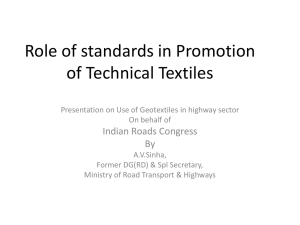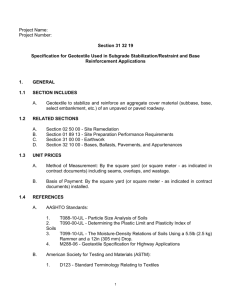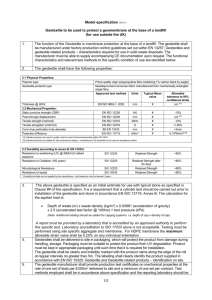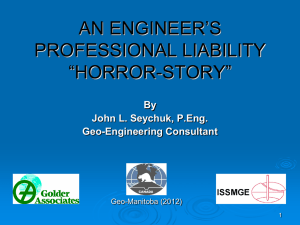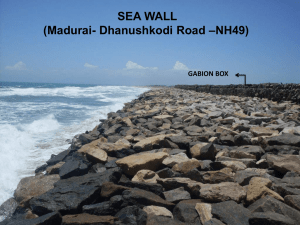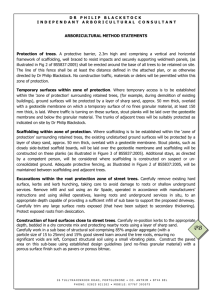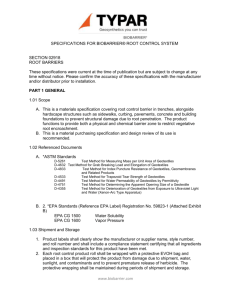Geotextile Underlayment for Hard Armor Erosion
advertisement
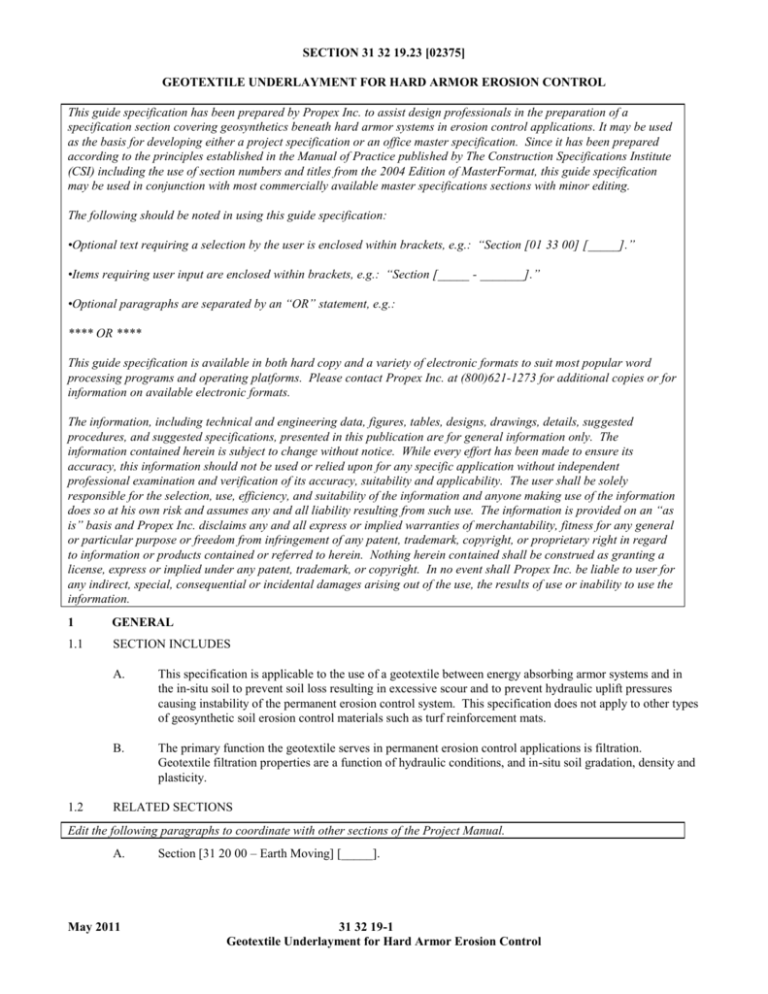
SECTION 31 32 19.23 [02375] GEOTEXTILE UNDERLAYMENT FOR HARD ARMOR EROSION CONTROL This guide specification has been prepared by Propex Inc. to assist design professionals in the preparation of a specification section covering geosynthetics beneath hard armor systems in erosion control applications. It may be used as the basis for developing either a project specification or an office master specification. Since it has been prepared according to the principles established in the Manual of Practice published by The Construction Specifications Institute (CSI) including the use of section numbers and titles from the 2004 Edition of MasterFormat, this guide specification may be used in conjunction with most commercially available master specifications sections with minor editing. The following should be noted in using this guide specification: •Optional text requiring a selection by the user is enclosed within brackets, e.g.: “Section [01 33 00] [_____].” •Items requiring user input are enclosed within brackets, e.g.: “Section [_____ - _______].” •Optional paragraphs are separated by an “OR” statement, e.g.: **** OR **** This guide specification is available in both hard copy and a variety of electronic formats to suit most popular word processing programs and operating platforms. Please contact Propex Inc. at (800)621-1273 for additional copies or for information on available electronic formats. The information, including technical and engineering data, figures, tables, designs, drawings, details, suggested procedures, and suggested specifications, presented in this publication are for general information only. The information contained herein is subject to change without notice. While every effort has been made to ensure its accuracy, this information should not be used or relied upon for any specific application without independent professional examination and verification of its accuracy, suitability and applicability. The user shall be solely responsible for the selection, use, efficiency, and suitability of the information and anyone making use of the information does so at his own risk and assumes any and all liability resulting from such use. The information is provided on an “as is” basis and Propex Inc. disclaims any and all express or implied warranties of merchantability, fitness for any general or particular purpose or freedom from infringement of any patent, trademark, copyright, or proprietary right in regard to information or products contained or referred to herein. Nothing herein contained shall be construed as granting a license, express or implied under any patent, trademark, or copyright. In no event shall Propex Inc. be liable to user for any indirect, special, consequential or incidental damages arising out of the use, the results of use or inability to use the information. 1 GENERAL 1.1 SECTION INCLUDES 1.2 A. This specification is applicable to the use of a geotextile between energy absorbing armor systems and in the in-situ soil to prevent soil loss resulting in excessive scour and to prevent hydraulic uplift pressures causing instability of the permanent erosion control system. This specification does not apply to other types of geosynthetic soil erosion control materials such as turf reinforcement mats. B. The primary function the geotextile serves in permanent erosion control applications is filtration. Geotextile filtration properties are a function of hydraulic conditions, and in-situ soil gradation, density and plasticity. RELATED SECTIONS Edit the following paragraphs to coordinate with other sections of the Project Manual. A. May 2011 Section [31 20 00 – Earth Moving] [_____]. 31 32 19-1 Geotextile Underlayment for Hard Armor Erosion Control 1.3 UNIT PRICES Include the following article only for unit price contracts or lump sum contract with unit price adjustments. Delete for lump sum contracts. 1.4 A. Method of Measurement: By the square meter (or square yard as indicated in contract documents) including seams, overlaps, and wastage. B. Basis of Payment: By the square meter (or square yard - as indicated in contract documents) installed. REFERENCES The following article assumes that the date of each reference standard will be the latest edition as of the date of the project specification. This provision must be defined in Division 1; coordinate with Division 1 statement. A. American Association of State Highway and Transportation Officials (AASHTO) “Standard Specification for Geotextile Specification for Highway Applications” Designation M 288-05 B. AASHTO Test Standards: C. 1.5 1. T 88 – Standard Test Method for Particle Size Analysis of Soils 2. T 90 – Standard Test Method for Determining the Plastic Limit and Plasticity Index of Soils 3. T 99 – Standard Practice for Determination of the Moisture Density Relations of Soils Using a 5.5 lb hammer and 12 in drop (Standard Proctor) American Society for Testing and Materials (ASTM): 1. D 123 – Standard Terminology Relating to Geotextiles 2. D 276 – Standard Test Method for Identification of Fibers in Textiles 3. D 3786 - Standard Test Method for Hydraulic Bursting Strength of Knitted Goods and Nonwoven Fabrics. 4. D 4354 - Practice for Sampling of Geosynthetics for Testing. 5. D 4355 - Test Method for Deterioration of Geotextiles from Exposure to Ultraviolet Light and Water (Xenon-Arc Type Apparatus). 6. D 4439 - Terminology for Geotextiles. 7. D 4491 - Test Method for Water Permeability of Geotextiles by Permittivity. 8. D 4533 - Test Method for Index Trapezoid Tearing Strength of Geotextiles. 9. D 4632 - Test Method for Grab Breaking Load and Elongation of Geotextiles. 10. D 4759 - Practice for Determining the Specification Conformance of Geosynthetics. 11. D 4751 - Test Method for Determining Apparent Opening Size of a Geotextile. 12. D 4833 - Test Method for Index Puncture Resistance of Geotextiles, Geomembranes, and Related Products. 13. D 4873 - Guide for Identification, Storage, and Handling of Geotextiles. DEFINITIONS A. Minimum Average Roll Value (MARV): Property value calculated as typical minus two standard deviations. Statistically, it yields a 97.7 percent degree of confidence that any sample taken during quality assurance testing will exceed value reported. B. Maximum Average Roll Value (MaxARV): Property value calculated as typical plus two standard deviations. Statistically, it yields a 97.7 percent degree of confidence that any sample taken during quality assurance testing will be below the value reported. May 2011 31 32 19-2 Geotextile Underlayment for Hard Armor Erosion Control C. 1.6 Typical Roll Value: Property value calculated from average or mean obtained from test data. SUBMITTALS Edit the following to coordinate with Division 1. A. Submit under provisions of Section [01 33 00] [_____]: 1. 2. 1.7 1.8 Certification: a) The Contractor shall provide the Engineer a certificate stating the name of the geotextile manufacturer, product name, style, chemical compositions of filaments or yarns and other pertinent information to fully describe the geotextile. b) The Manufacturer is responsible for establishing and maintaining a quality control program to assure compliance with the requirements of the specification. Documentation describing the quality control program shall be made available upon request. c) The manufacturer’s certificate shall state that the furnished geotextile meets MARV requirements of the specification as evaluated under the manufacturer’s quality control program. A person having legal authority to bind the Manufacturer shall attest to the certificate. Manufacturing Quality Control (MQC) test results shall be provided upon request. DELIVERY, STORAGE, AND HANDLING A. Geotextile labeling, shipment and storage shall follow ASTM D 4873. B. Product labels shall clearly show the manufacturer or supplier name, style name, and roll number. C. Each shipping document shall include a notation certifying that the material is in accordance with the manufacturer’s certificate. D. Each geotextile roll shall be wrapped with a material that will protect the geotextile from damage due to shipment, water, sunlight, and contaminants. E. The protective wrapping shall be maintained during periods of shipment and storage. If the wrapping is damaged prior to installation, the outer wrap of geotextile material must be discarded before installation. F. During storage, geotextile rolls shall be elevated off the ground and adequately covered to protect them from the following: Site construction damage, extended exposure to ultraviolet (UV) radiation, precipitation, chemicals that are strong acids or strong bases, flames, sparks, temperatures in excess of 71 deg C (160 deg F) and any other environmental condition that might damage the geotextile. QUALITY ASSURANCE SAMPLING, TESTING, AND ACCEPTANCE A. B. May 2011 Geotextile: 1. Geotextiles shall be subject to sampling and testing to verify conformance with this specification. Sampling for testing shall be in accordance with ASTM D 4354. 2. Acceptance shall be in accordance with ASTM D 4759 based on testing of either conformance samples obtained using Procedure A of ASTM D 4354, or based on manufacturer’s certifications and testing of quality control samples obtained using Procedure B of ASTM D 4354. Sewn Seams (if required): 1. For seams that are to be sewn in the field, the Contractor shall provide at least a 2 meter (6 ft) length of sewn seam for sampling by the Engineer before the geotextile is installed. 2. For seams that are sewn in the factory, the Engineer shall obtain samples of the factory seams at random from and roll of geotextile that is to be used on the project. 31 32 19-3 Geotextile Underlayment for Hard Armor Erosion Control 3. If seams are to be sewn in both directions, samples of seams from both directions shall be provided. 4. For seams that are field sewn, the seams sewn for sampling shall be sewn using the same equipment and procedures as will be used for the production seams. 5. The Contractor along with the sample of the seam shall submit the seam assembly description. The description shall include the seam type, sewing thread, and stitch density. 2 PRODUCTS 2.1 MANUFACTURERS A. Propex Inc., Chattanooga, Tennessee, 37422 USA, Phone (800) 621-1273. Edit the following to coordinate with Division 1. B. 2.2 Substitutions: Under provisions of Section [01 25 00] [_____]. MATERIALS These geosynthetics should be used in erosion control applications where installation stresses are severe, with stone placement height less than 1 meter (3 ft) and stone weights not exceeding 110 kilograms (240 lbs). A. Geotextile: 1. Polypropylene, staple fiber, needlepunched nonwoven heat set on one side to ensure consistent roll width and rollout, or a woven monofilament. 2. Resistant to ultraviolet degradation and to biological and chemical environments normally found in soils. Include the following for Type I (AASHTO woven monofilament Class 2) geotextile (GEOTEX ® 104F). Use Type I when soil to be filled consists of well-graded sands and gravel with 15% to 50% fines. 3. May 2011 Minimum Average Roll Values: Property Test Method Units Grab Tensile Strength ASTM D 4632 N (lbs) Property Requirement 1647 x 1113 (370 x 250) Grab Elongation ASTM D 4632 Percent 15 x 15 Puncture Strength ASTM D 4833 N (lbs) 534 (120) Mullen Burst ASTM D 3786 kPa (psi) 3102 (450) Trapezoidal Tear ASTM D 4533 N (lbs) 445 x 267 (100 x 60) Percent Open Area Area of Openings divided by Total Area x 100 Percent 4-6 Permittivity ASTM D 4491 sec-1 0.28 Water Flow Rate ASTM D 4491 l/min/m2 (gpm/ft2) 733 (18) UV Resistance (percent retained at 500 hours) ASTM D 4355 Percent 90 31 32 19-4 Geotextile Underlayment for Hard Armor Erosion Control **** OR **** Include the following for Type II (AASHTO Nonwoven – Class 1) geotextile (GEOTEX® 801). Use Type II when soil to be filtered is cohesive. 4. Minimum Average Roll Values: Property Test Method Units Grab Tensile Strength ASTM D4632 N (lbs) Property Requirement 912 (205) Grab Elongation ASTM D4632 Percent 50 Trapezoidal Tear ASTM D 4533 Apparent Opening Size ( Maximum Average Roll Value) Permittivity ASTM D 4751 N (lbs) mm (US Std. Sieve) 356 (80) 0.180 (80) ASTM D 4491 sec-1 1.50 Water Flow Rate ASTM D 4491 l/min/m2 (gpm/ft2) 4482 (110) UV Resistance (Percent retained at 500 hours) ASTM D 4355 Percent 70 **** OR **** Include the following for Type III geotextile (GEOTEX ® 111F). Use Type III when soil to be filtered consists of wellgraded sand or gravel with less than 15% fines. 5. Minimum Average Roll Values: Property Test Method Units Grab Tensile Strength ASTM D4632 Grab Elongation ASTM D4632 N (lbs) Percent Property Requirements 1645 x 980 (370 x 220) 25 x 15 Puncture Strength ASTM D4833 N (lbs) 510 (115) Mullen Burst ASTM D 3786 kPa (psi) 3240 (470) Trapezoidal Tear ASTM D 4533 N (lbs) mm (US Std. Sieve) Percent 510 x 335 (115 x 75) 0.600 (30) Apparent Opening Size ASTM D 4751 May 2011 Percent Open Area Area of Openings divided by Total Area x 100 8 Permittivity ASTM D 4491 sec-1 1.5 Water Flow Rate ASTM D 4491 l/min/m2 (gpm/ft2) 4685.1 (115) 31 32 19-5 Geotextile Underlayment for Hard Armor Erosion Control UV Resistance (Percent retained at 500 hours) 6. Percent 90 Quality Control a) Manufacturing Quality Control (MQC): Testing shall be performed at a laboratory accredited by GAI-LAP for tests required for the geotextile, at frequency exceeding ASTM D 4354. B. Retaining Pins: 4 mm (0.18 in) diameter x 450 mm (18 in) long steel pins, pointed at one end and fitted with 35 mm (1 in) diameter washer at other end. C. Sewing Thread (if required) 1. Sewing thread shall consist of high strength polypropylene or polyester (Nylon shall not be used). 2. The thread shall be of a contrasting color to the geotextile. 3 EXECUTION 3.1 PREPARATION 3.2 ASTM D 4355 A. Prepare surfaces to receive geosynthetic to smooth condition as indicated or as directed by Engineer. B. Fill depressions and holes flush with adjacent surfaces. C. Remove large stones, limbs, and other debris prior to placement of geosynthetic. INSTALLATION A. The geotextile shall be placed in intimate contact with the soils without wrinkles or folds and anchored on a smooth graded surface approved by the Engineer. The geotextile shall be placed in such a manner that placement of the overlying materials will not excessively stretch so as to tear the geotextile. Anchoring of the terminal ends of the geotextile shall be accomplished through the use of key trenches or aprons at the crest and toe of slope. B. 450 mm (18 in) anchoring pins placed on 600 to 1800 mm (24 to 45 in) centers, depending on the slope of the covered area, may be used to expedite construction. C. The geotextile shall be placed with the machine direction parallel to the direction of water flow which is normally parallel to the slope for erosion control runoff and wave action and parallel to the stream or channel in the case of streambank and channel protection. Either sewing or overlapping shall join adjacent geotextile sheets. Overlapped seams of roll ends shall be a minimum of 300 mm (12 in) except where placed under water. In such instances the overlap shall be a minimum of 1 m (3 ft). Overlaps of adjacent rolls shall be a minimum of 300 mm (12 in) in all instances. D. When overlapping, successive sheets of the geotextile shall be overlapped upstream over downstream, and/or upslope over downslope. In cases where wave action or multidirectional flow is anticipated, all seams perpendicular to the direction of flow shall be sewn. E. Care shall be taken during installation so as to avoid damage occurring to the geotextile as a result of the installation process. Should the geotextile be damaged during installation, a geotextile patch shall be placed over the damaged area extending 1 m (3 ft) beyond the perimeter of the damage. F. The armor system placement shall begin at the toe and proceed up the slope. Placement shall take place so as to avoid stretching and subsequent tearing of the geotextile. Riprap and heavy stone filling shall not be dropped from a height of more than 300 mm (12 in). Stone with a mass of more than 100 kg (225 lb) shall not be allowed to roll down the slope. May 2011 31 32 19-6 Geotextile Underlayment for Hard Armor Erosion Control 3.3 G. Slope protection and smaller sizes of stone filling shall not be dropped from a height exceeding 1 m (3 ft), or a demonstration provided showing that the placement procedures will not damage the geotextile. In underwater applications, the geotextile and backfill material shall be placed the same day. All void spaces in the armor stone shall be backfilled with small stone to ensure full coverage. H. Following the placement of the armor stone, grading of the slope shall not be permitted if the grading results in movement of the stone directly above the geotextile. I. Field monitoring shall be performed to verify that the armor system placement does not damage the geotextile. J. Any geotextile damaged during backfill placement shall be replaced as directed by the Engineer, at the Contractor’s expense. PROJECTION A. Atmospheric exposure of the geotextile to the elements following laydown shall be limited to 14 days to prevent damage. END OF SECTION May 2011 31 32 19-7 Geotextile Underlayment for Hard Armor Erosion Control

